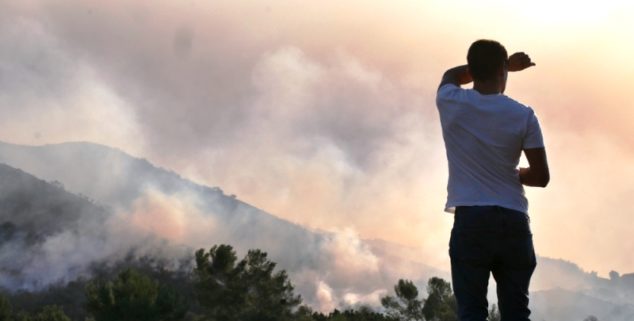News
California fights fires amid COVID-19 and a tight budget
 A man watches the 2018 Woolsey fire in Los Angeles. (Photo: BrittanyNY, via Shutterstock)
A man watches the 2018 Woolsey fire in Los Angeles. (Photo: BrittanyNY, via Shutterstock)Strapped California, facing an unprecedented budget crisis as it battles COVID-19, is setting aside hundreds of millions of dollars to fight wildfires. Already, more than 1,300 fires — mostly small — have been reported as the hottest, driest months of the year approach.
“From a fiscal standpoint, we’re preparing for another bad fire year,” said Finance Department spokesman H.D. Palmer.
State and federal authorities say about 7,860 fires burned an estimated 259,823 acres in 2019.
The Legislative Analyst’s Office, the Legislature’s nonpartisan fiscal adviser, projected an increased fire risk due to “increased development in fire‑prone areas, unhealthy forest lands, climate change, and the role of utility infrastructure management.”
The analysis is based in part on California’s recent history: Wildfires have been destructive and deadly.
The most severe wildfire, the Camp Fire of 2018 in Butte County that was caused by sparking power lines, resulted in about 85 fatalities and the destruction of over 18,800 structures. While the Camp Fire was the most horrific, more than 7,571 wildfires burned over 1.8 million acres across the state of California in 2018.
According to the state Department of Forestry and Fire Protection (Cal Fire) and the U.S. Forest Service, around 7,860 fires burned an estimated 259,823 acres in 2019.
Cal Fire’s Emergency Fund shows that fire suppression costs for the 2018-19 fiscal year totaled about $635 million. For the current fiscal year, 2019-20, an estimated $91 million.
Through mid-March, more than 1,300 fires have burned across over 1,540 acres.
Jessica Peters, an LAO policy analyst, described the main components of wildfire budgeting in a December 2019 report, prior to the impact of the coronavirus epidemic.
The question, however, is whether the state can commit this level of funding amid the pandemic.
California “has budgeted about $2.5 billion for wildfire prevention and response activities for Cal Fire. This includes roughly $1.8 billion of baseline resources for fire suppression, including year‑round and seasonal firefighters,” the analysis noted.
In the event of unprecedented times, such as that of the current COVID-19 climate, “the budget includes a set‑aside — the Emergency Fund (E‑Fund) — that provides additional funding as needed for emergency wildfire response.”
The question, however, is whether the state can commit this level of funding amid the pandemic. The administration has estimated the deficit at $54 billion, while the LAO puts it at $18 billion to $35 billion.
Palmer, a deputy director of the Department of Finance, which writes the governor’s budgets, said that “even though we’re dealing with a pandemic and a budget crisis, we can’t take a vacation from being prepared to fight fires.”
The department is “looking at an adjusted five-year average cost of fighting wildfires,” and Palmer said the recently revised budget changes provide “just over a quarter of a billion dollars for the Emergency Wildfire Suppression Act, precisely $276.2 million.”
Californians “need to be prepared because California doesn’t have fire season, we have fire year.” — Mike Mohler
“Even though we’ve had to cut back, we’re still putting a quarter a billion dollars aside with the recognition that we are looking at a bad fire year ahead of us and we want to have the resources on hand to be able to be prepared for that,” he said.
The budget, which takes effect July 1, must be approved by lawmakers and sent to the governor by June 15, the constitutional deadline. Deliberations on the budget are under way in the Capitol.
Gov. Gavin Newsom’s May 14 Budget Summary notes that “despite the significant budget shortfall [as a result of COVID-19], the May Revision reflects an additional $90 million General Fund ($142.7 million ongoing) to further enhance Cal Fire’s fire protection capabilities for the 2020 fire season and beyond.”
Such revisions include the Cal Fire Staffing and Early Ramp-Up of 2020 Fire Season Surge Capacity— to “maintain $85.6 million General Fund ($135.1 million ongoing) for permanent firefighting positions to provide Cal Fire with operational flexibility throughout the peak fire season and beyond as fire conditions dictate.”
Cal Fire’s Mike Mohler warns Californians “need to be prepared because California doesn’t have fire season, we have fire year,” predicting “moderate, if not higher, fire activity.”
With social distancing restrictions, the public may wonder about safety in the midst of the double disasters of wildfires and pandemic.
Mohler says that while firefighters practice safety “just like the public would” to keep their employees and the public safe, “at no time will social distancing impact the care given to save somebody’s life” especially “if it’s a matter of life, there is no second guessing on social distancing.”
“We will never be held back in response to a major disaster because of funding … it is never going to stop us from protecting life and property,” he added.
Looking forward, how should California prepare?
The LAO’s Peters recommends that “the state would benefit from engaging in a longer-term, more robust planning process around how to mitigate the risks to these catastrophic and devastating wildfires.”
Mohler adds: “We don’t want the public to go into crisis fatigue … the public needs to be our partners” referring to potential, life-saving evacuation orders.
—
Editor’s Note: Sabrina Zunich is a Capitol Weekly intern from UC Davis.
Want to see more stories like this? Sign up for The Roundup, the free daily newsletter about California politics from the editors of Capitol Weekly. Stay up to date on the news you need to know.
Sign up below, then look for a confirmation email in your inbox.

Leave a Reply